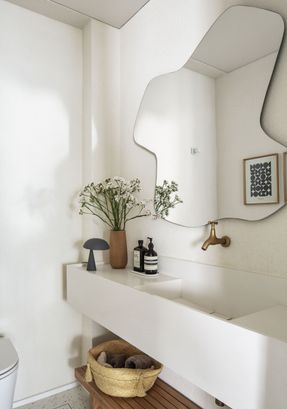Ibiapinópolis Apartment
ARCHITECTS
Ana Sawaia Arquitetura
ARCHITECT IN CHARGE
Ana Sawaia
MANUFACTURERS
Artefatos Engenharia Metálica, Atenua Som, Atlas, By Kamy, Docol, Dpot, Estúdio Bola, Gustavo Bittencourt, Keramika, Lumini, Ovoo, Paulo Alves, Reka, Santana, Styntec, Tom Mármores
PROJECT TEAM
Juliana Chamma Baumgart
LANDSCAPE DESIGN
Estudio Oh
LANDSCAPE COLLABORATOR
Jardins De Luz
SOUND SYSTEM DESIGN
Fernanda Duarte
WOODWORK
Laurel
KITCHEN
Securit
CONSTRUCTION
Plano Engenharia
YEAR
2023
LOCATION
São Paulo, Brazil
CATEGORY
Apartment Interiors
Text description provided by architect.
Located in a building from 1973 in the Jardim Paulistano neighborhood in São Paulo, the 260m2 apartment is on the 3rd floor, with a view of the treetops visible through all the windows of the living room.
The residents, a couple with two young children, wanted to expand the spaces to larger environments and integrate the kitchen with the living area.
Walls in the entrance hall, dining room, and living room were removed. However, a large concrete pillar 1.80m wide separated the kitchen from the living room.
With the intention of revealing the structure, the covering on the pillar and beams between the living room and kitchen was removed.
A large carpentry panel with vertical grooves was made, showcasing a sequence of doors to the kitchen, wine cellar, entrance door, and powder room, camouflaging them and creating a rhythmic composition for this plane, providing visual unity, removing access interrupted by corridors, and improving circulation flow.
Concrete also appears in the on-site built-in bookshelves and countertops, with 3cm thick shelves housing the dining room buffet and TV cabinet, featuring solid Tauari wood lattice doors.
Sliding doors with wired glass separate the office from the living room and the kitchen from the service area, allowing natural light to pass between the spaces.
The original wooden flooring in the living area and bedrooms was restored, and a wooden deck was installed over the balcony floor.
The kitchen was a challenge. It had little natural light, and the circulation occupied too much space due to multiple access points.
To meet the residents' needs, a curved cabinet was designed to allow fluid circulation and ample storage space, made of perforated and rolled metal sheet, housing appliances and a lit niche.
The kitchen table was made of concrete, also molded on-site, with a 1.40m overhang.
The national travertine marble removed from the bathrooms was completely reused.
Instead of being discarded, it was used in the composition of terrazzo flooring in the kitchen, service area, and powder room, both in the pebble base and in variously sized triangle-cut shards.
The furniture is predominantly from Brazilian designers, such as Gustavo Bittencourt, Domingos Tótora, Sergio Bernardes, Paulo Alves, Estúdio Bola, Luciana Martins, Gerson de Oliveira, and Lina Bo Bardi.

































